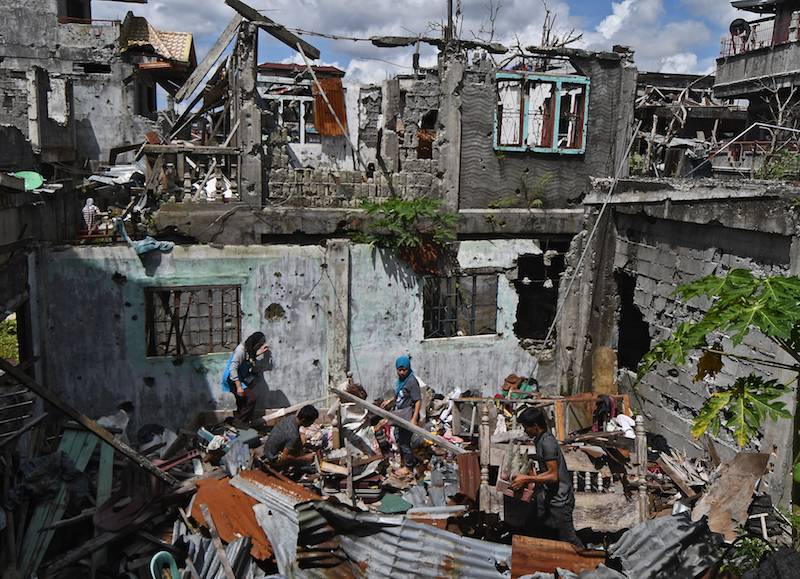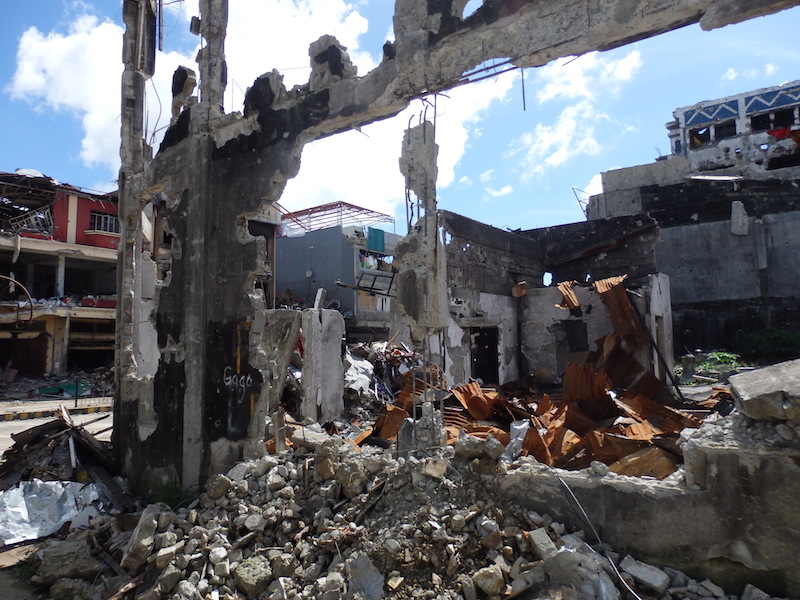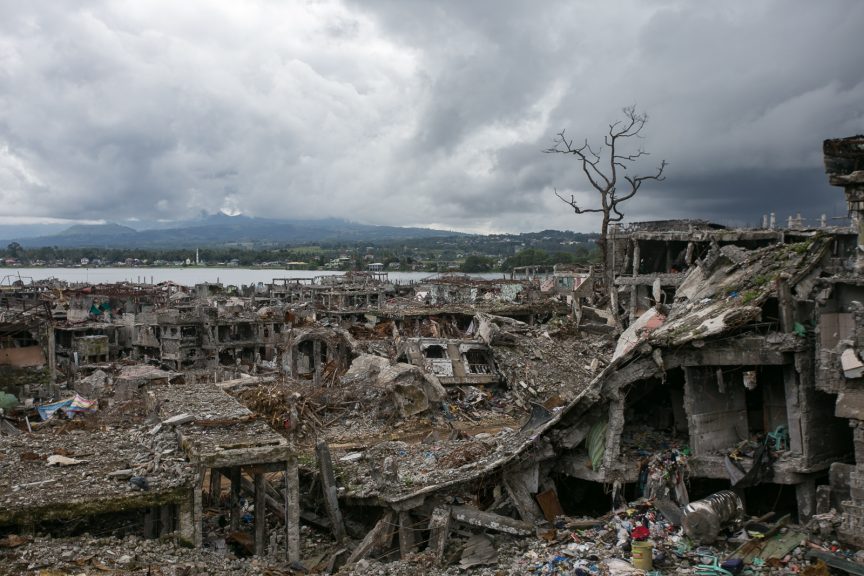DAVAO CITY (MindaNews / 11 April) — As the nation prepares for the filing of certificates of candidacy on April 14 to 20 for the May 14 election of barangay and Sangguniang Kabataan officials, voters in Marawi’s 96 barangays will have to wait for when it is feasible to hold elections in a city still trying to recover from the destruction and displacement wrought by the five-month siege last year.
In Mindanao, which is presently under martial law, the Commission on Elections’ (Comelec) Minute Resolution 18-0085 on January 31, 2018 said elections will proceed as scheduled in all six regions “with the exception of Marawi City, the rehabilitation of which is ongoing,”
The Resolution also directed the election and Barangay Affairs Department to “conduct a physical/ocular/structural integrity study or assessment of the polling precincts in Marawi City and recommend whether or not to conduct election therein three months after the scheduled May 14, 2018 BSKE elections.”
 Residents search for items they could salvage from what remains of their house in Marawi’s Ground Zero or Most Affected Area (MAA) on April 5, 2018, under the Kambisita sa MAA project of the city government of Marawi and Task Force Bangon Marawi. Kambisita allows Ground Zero residents to visit their homes – or what remains of them – for three days from April 1 to May 10.
Residents search for items they could salvage from what remains of their house in Marawi’s Ground Zero or Most Affected Area (MAA) on April 5, 2018, under the Kambisita sa MAA project of the city government of Marawi and Task Force Bangon Marawi. Kambisita allows Ground Zero residents to visit their homes – or what remains of them – for three days from April 1 to May 10.
But they will be able to return and rebuild their homes only on the first quarter of 2020. MindaNews photo by FROILAN GALLARDO
Comelec spokesperson James Jimenez told MindaNews that a reassessment of the prevailing conditions in Marawi will be undertaken three months after the May 2018 polls.
Meanwhile, he said, incumbent barangay officials will continue to serve on holdover capacity.
Out of 96 barangays in Marawi City, 24 barangays comprise the 250-hectare Ground Zero, the main battle area between government forces and the ISIS-inspired Maute Group and its allies, and the object of daily air strikes during the five-month siege. It is now referred to as the Most Affected Area or MAA.
The war rendered the residential and commercial structures there uninhabitable and residents there have not been allowed to return to their villages except for three days per sector from April 1 to May 10 through the “Kambisita sa MAA” (Visit MAA) initiative of Task Force Bangon Marawi (TFBM) and the City Government of Marawi.
Housing Secretary Eduardo del Rosario, TFBM chair, told MindaNews last Friday that Ground Zero residents can return to their villages to rebuild their homes “most likely first quarter 2020” after the debris clearing and site development.
“Ghost villages”
With the territory of the 24 barangays rendered off limits to residents until “most likely first quarter 2020,” what will happen to its dispersed residents? Who will represent them? Will the officials of the 24 barangays also serve on holdover capacity even if their barangays are practically “ghost villages”?, MindaNews asked.
Jimenez replied: “As far as the Comelec and election concerns are involved, holdover ang turing sa kanila (they are considered on holdover). With regard to their official functions — i.e., what they’re expected to do with no constituents to speak of — that’s a matter falling within the jurisdiction of the DILG (Department of Interior and Local Government),” he said.
MindaNews sought DILG Secretary Eduardo Ano for comment but he has yet to send his reply.
 Ground Zero. MIndaNews photo taken November 24, 2017 by Carolyn O. Arguillas
Ground Zero. MIndaNews photo taken November 24, 2017 by Carolyn O. Arguillas
Under the Local Government Code, a barangay must have a “contiguous territory” and a “population of at least 2,000” as certified by the National Statistics Office except in cities and municipalities in Metro Manila and other metropolitan political subdivisions or in highly urbanized cities which require a certified population of at least 5,000.
The 24 barangays in Ground Zero are Banggolo Poblacion, Bubonga Lilod Madaya, Daguduban, Dansalan, Datu Naga, Datu sa Dansalan, Kapantaran, Lilod Madaya (Poblacion), Lumbac Marinaut, Lumbaca Madaya (Poblacion), Marinaut East, Marinaut West, Moncado Colony, Moncado Kadilingan, Norhaya Village, Raya Madaya 1, Raya Madaya 2, Sabala Manao, Sabala Manao Proper, Tolali, Tuca Marinaut, Wawalayan Marinaut, Sangcay Dansalan, South Madaya Proper.
These villages constitute the most populous area in the city as it is not only residential but also a commercial district as well.
Remained, Returned, Still dispersed
According to the Philippine Statistics Authority, Marawi City’s population as of the 2015 census was 201,785. The daytime population, however, is much higher as Marawi City is the center of trade and commerce in Lanao del Sur.
The Department of Social Welfare and Development reported a total of 78,466 families or 359,680 persons displaced from Marawi and neighboring towns due to the armed conflict.
Displaced Marawi residents fled the city and sought refuge in at least nine regions in the country, most of them in neighboring towns and cities in Northern Mindanao and the Autonomous Region in Muslim Mindanao while the rest fled to other parts of Mindanao, Visayas and even in Metro Manila. Not all have returned home. Not all still have homes to return to.
In his Powerpoint presentation before the Malacanang Press Corps on April 6, Del Rosario presented a slide showing that a total of 52,178 families or 181,873 individuals have been monitored to have remained in the 20 villages that did not evacuate and in 52 of 76 villages where residents have returned after fleeing the war last year. The population of the 24 villages that constitute Ground Zero, however, remains dispersed.
 AFTERMATH OF TERROR. The view from Ground Zero along Quezon Avenue, beside the Bato Ali Mosque on 25 October 2017. MindaNews file photo by MANMAN DEJETO
AFTERMATH OF TERROR. The view from Ground Zero along Quezon Avenue, beside the Bato Ali Mosque on 25 October 2017. MindaNews file photo by MANMAN DEJETO
The slide also showed that residents in 20 barangays — 6,901 families or 45,442 individuals — did not leave the city during the five-month siege; 38,699 families or 103,541 individuals who fled the war have returned to 48 barangays while 6,578 families or 32,890 individuals, representing 72% have returned to four other barangays.
Del Rosario said the timeline for the debris clearing and site development in the 24 barangays comprising Ground Zero is “about 18 months” from June 7, the target date for groundbreaking.
“We will only allow (residents to rebuild) once the developer is through with their site development in providing the utilities, then the individual private owners of lots can apply for a building permit from the city government,” del Rosario said.
Eighteen months from June 2018 is December 2019. (Carolyn O. Arguillas / MindaNews)
